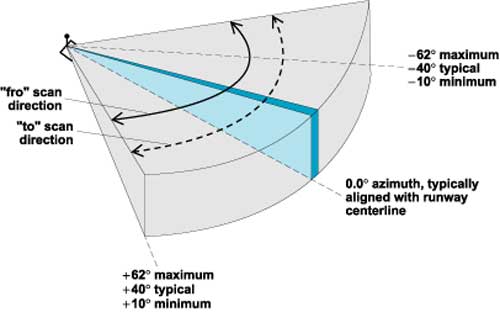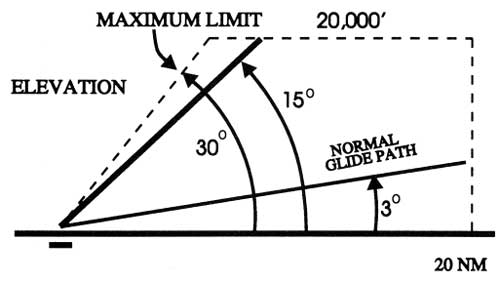The MLS is a system of precission approach for landing by instruments and constitutes a kind of an alternative to the ILS system. It provides information about the azimuth, optimal angle of descent and the distance, as well as data about the reverse course in case of an unsuccessful approach. It has several advantages compared to the ILS, for example a greater number of possible executed approaches, a more compact ground equipment, and a potential to use more complicated approach trajectories. However for certain reasons, in particular the advancement of the GPS satelite navigation, was the installation of new devices halted and finally in 1994 completely canceled by the FAA organization. On european airports we can rather seldom come across an MLS.
The MLS provides an accurate landing approach for an aircraft in the area of the final approach, where the path of the final approach isn’t identical with the enlonged runway’s axis. The system works with a microwave beam that is transmitted towards the sector of approach and scans the sector both in the horizontal as well as the verical plane. An aircraft in the approach sector receives the signal and with the help of this beam evaluates it’s location in space. The aircraft’s position is therefore determined both in the horizontal direction of approach and the vertical plane, in whatever point of reach of the scanning beam. Because the microwave technology is radiated into the space of approach in a given time and it’s not spread out over different directions, no signal interruption results from various obstacles or terrain protrusions as it was with the ILS system. The MLS system can thus be situated also in developed areas, where an ILS system couldn’t be set up. An onboard computer enables to solve the approach manoeuvre from a random direction, for variously oriented runways, even along a curved of bend landing trajectory. The MLS system is approved by the ICAO for every three categories of an accurate landing approach.

 Figure 1 – A display of the MLS components and their approximate placement beside the runway.
Figure 1 – A display of the MLS components and their approximate placement beside the runway. Figure 2 – Scheme of a ground protractor set-up of the MLS system.
Figure 2 – Scheme of a ground protractor set-up of the MLS system. Figure 3 – An illustration of the horizontal signal’s coverage and it’s oscillation.
Figure 3 – An illustration of the horizontal signal’s coverage and it’s oscillation. Figure 4 – An illustration of the vertical signal’s coverage for various glide slope angles.
Figure 4 – An illustration of the vertical signal’s coverage for various glide slope angles.